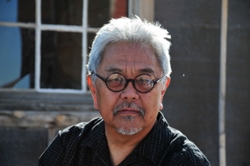While attending an auction many years ago, a farmer asked Roger Shimomura how he came to know English so well.
Shimomura, a Japanese American, had grown accustomed to the question.
“In the Midwest, there’s a general presumption among most people that if you are not white, you must be a foreigner,” he says. “It’s insulting as well as painful. It’s something that’s difficult to describe unless you experience it.”
Shimomura, a nationally renown artist, will speak of this and other life experiences during his talk, “An American Diary,” Jan. 23 at Willamette University.
During the free lecture, Shimomura will share how stereotypes of Japanese Americans, issues of ethnicity and the two years he spent in a Japanese-American internment camp during World War II have influenced his paintings, prints and experimental theater pieces.
The lecture is part of a week-long series of campus and community events planned to honor Martin Luther King Jr.’s life and work.
“Martin Luther King didn’t just represent African Americans. He represented all people of color,” Shimomura says. “It’s so evident. People of color face the same issues. It’s a common fight.”
Finding Connections
Shimomura, a Kansas-based artist, was born in Seattle. He spent two years of his early childhood in Minidoka, Idaho — one of 10 internment camps for Japanese Americans during World War II. He later went on to earn his bachelor’s degree from the University of Washington and a Master of Fine Arts from Syracuse University in New York.
His works, which weave together his childhood interest in comic books, American Pop Art and Japanese woodblock prints, are exhibited throughout the nation. The Hallie Ford Museum of Art is displaying many of his paintings in the show, “Roger Shimomura: An American Knockoff,” Jan. 17 through March 29.
Shimomura’s art — and his story — resonate with Gordy Toyama, director of Multicultural Affairs.
“Both my parents were interred in a camp as teenagers,” he says. “My dad would not talk about it. I think it brought great shame to him that he was imprisoned because of the color of his skin. Once he passed away, I knew I could bring this conversation forward to honor his life and his memory.”
Toyama says it’s important for people to hear from Shimomura and others to better understand the continued struggles of displaced communities — from Native Americans living on reservations to detainees placed in Guantanamo Bay’s detention camp.
“These things are still happening in our prison system. These injustices still exist on our reservations. But there are no reparations for a lot of these communities,” Toyama says. “It’s the hysteria of the unknown that’s making people with power react the way they are.”
As for Shimomura, he hopes people attending his lecture will leave with a better understanding of the ways in which his life and his art connect.
“A great deal of what I will show will be images of what I collect,” he says. “These kinds of collections have brought clarity into my life, and I’d like to share that with the audience.”
Ticket Information
The lecture will begin at 7:30 p.m. in Rogers Music Center’s Hudson Hall. Doors open at 6:30 p.m.
Free tickets are available online at willamette.edu/go/mlktickets. They are also available from 9 a.m. to 4 p.m. on the second floor of the Putnam University Center on Jan. 23.
In addition to Shimomura, the lecture will feature Lawson Inada, a third-generation Japanese American, who was sent to internment camps with his family during World War II. Inada was appointed Oregon poet laureate in 2006. Both jazz and his experience in internment camps have influenced his writing.

